Sacrifices of February 5 in Indian Freedom Struggle
Table of Contents
ToggleThe Heroes of 1857 Uprising
On February 5, 1858, the Indian Freedom Struggle witnessed the execution of brave individuals from Nagli, Haryana. Bhooliah, Bhulla, Bishumber, and others actively opposed British rule. Their resistance highlighted their courage. Despite their efforts, they were captured and executed, marking a significant day of sacrifice.
The Chauri Chaura Incident
During the Non-Cooperation Movement, Abdulla alias Sukaee and Bhagwan became symbols of defiance. Involved in the Chauri Chaura incident, their actions led to their execution on July 2, 1923. This event underlines the struggle against British oppression.
The Legacy Continues: February 5 in the Indian Freedom Struggle
The Anti-Begar Movement and Amar Singh
Ramesh Swami’s tragic death on February 5, 1947, during the anti-Begar movement, and Amar Singh’s demise in 1860, add layers to the narrative of resistance. Their stories are integral to understanding the depth of the Indian Freedom Struggle.
Remembering the Martyrs
Himangshu Mohan Basu and U Giri Daloi’s sacrifices remind us of the price paid for freedom. Dama Pujari’s death in 1943 and Lakha Singh’s demise in 1903 further emphasize the struggle’s harsh realities. These martyrs’ stories inspire us to honor the Indian Freedom Struggle’s legacy.
Revolutionary Sacrifices
The Indian Freedom Struggle is rich with tales of bravery and sacrifice. Himangshu Mohan Basu, a young revolutionary, met a grim fate in 1937, a casualty of brutal detention. U Giri Daloi’s stand in Shangpung in 1862 against British forces exemplifies the widespread resistance across India. These stories of valor beyond the battlefield deepen our appreciation for the struggle’s complexities.
The Cost of Resistance
Dama Pujari and Lakha Singh’s deaths bring to light the severe conditions and risks faced by freedom fighters. Pujari’s demise in 1943, due to neglect and poor conditions in detention, and Singh’s death in 1903 in a Burma jail, underscore the sacrifices made. Their endurances remind us of the high price of India’s freedom.
Reflections on February 5 in the Indian Freedom Struggle
These narratives from February 5 across different years of the Indian Freedom Struggle serve as poignant reminders of the sacrifices made for India’s independence. From the early resistance in 1857 to the pivotal movements in the 20th century, each story contributes to a collective memory of struggle, resilience, and the enduring pursuit of freedom. As we remember these heroes, their legacy continues to inspire and shape the values of courage, leadership, and perseverance in the fight for justice and autonomy,
Feature Image: The image is a poignant collage that intricately blends significant moments from the Indian Freedom Struggle, commemorated on February 5th. It features valiant heroes from the 1857 Uprising in Nagli, Haryana, scenes from the tragic Chauri Chaura incident, the sacrifice of Ramesh Swami during the anti-Begar movement, and the martyrdom of revolutionaries like Himangshu Mohan Basu and U Giri Daloi. Each segment of the collage vividly captures the essence of sacrifice, courage, and the relentless fight for freedom against British rule. The artwork is a unified representation of India’s struggle for independence, invoking a deep sense of reverence and reflection on the sacrifices made for freedom. The color palette conveys both the solemnity and the vibrancy of the freedom movement, making the painting a visual tribute to the enduring spirit of those who fought for India’s independence. (Click here to view the image)

Some genuinely good information, Sword lily I noticed this.
I?¦m no longer sure the place you are getting your info, but great topic. I needs to spend some time learning much more or working out more. Thanks for wonderful information I used to be looking for this information for my mission.